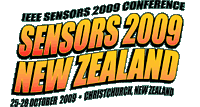

|
Tutorials Micro-Optic and Fiber Optic Sensors Terahertz Sensing Noise Harvesting Chemical and Gas Sensing Industrial Tomography Silicon Piezoresistive Stress Sensors Miniaturised Space Payloads Integrated Gas Sensors Sensors as Communication Channels Nanophotonic Sensors Biopolymer Detection Integrated Radar Sensors Ultrasonics |
Terahertz sensing technology has a promise of many breakthrough and enabling applications including detection of biological and chemical hazardous agents, cancer detection, detection of mines and explosives, enhancement of people, building, and airport security, covert communications (in THz and sub-THz windows), and applications in radioastronomy and space research. This lecture will review the famous "THz gap" and the-state-of-the-art of existing THz sources, detectors, and sensing systems. As application examples, I will discuss the THz space exploration, sensing of biological materials, broadband THz reflection and transmission detection of concealed objects, THz explosive identification, THz nanocomposite spectroscopy, and THz remote sensing. Most existing terahertz sources have low power and rely on optical means of the terahertz radiation. THz quantum cascade lasers using over thousand alternating layers of gallium arsenide and aluminum gallium arsenide have achieved the highest THz powers generated by optical means. Since the energy of a terahertz photon (4.2 meV for 1 THz) is much smaller than the thermal energy at room temperature, room temperature operation of THz lasers might be limited to the high frequency boundary of the terahertz range of frequencies (e.g. close to 30 THz). Improved designs and using quantum dot medium for THz laser cavities are expected to result in improved THz laser performance. Huge THz powers are generated using free electron lasers. Two-terminal semiconductor devices are capable of operating at the low bound of the THz range, with the highest frequency achieved using Schottky diode frequency multipliers (exceeding 1 THz). High speed three terminal electronic devices (FETs and HBTs) are approaching the THz range (with cutoff frequencies and maximum frequencies of operation around 600 GHz and 340 GHz for InGaAs and SiGe technologies respectively, and over 800 GHz for InGaAs-based Heterojunction Bipolar Transistors,). A new approach called plasma wave electronics recently demonstrated terahertz emission and detection in GaAs-based and GaN-based HEMTs and in Si MOS and SOI, including the resonant THz detection at room temperature. Biography Dr. Shur received MSEE. Degree (with honors) from St. Petersburg Electrotechnical Institute, and PhD. and Dr. Sc. Degrees from A. F. Ioffe Institute. He worked at Ioffe, Cornell, Oakland University, University of Minnesota, and UVa. He is now Roberts Professor, Director of Broadband Center, co-Director of the NSF I/UCRC, and Acting Director of Center for Integrated Electronics. He is Fellow of IEEE, APS, ECS, WIF, AAAS, and member of Eta Kappa Nu, Tau Beta Pi, MRS, ASEE, elected member and former Chair of US Commission D and former Member of URSI, life member of IEEE MTT, Sigma Xi, and Humboldt Society. Dr. Shur is Editor-in-Chief of IJHSES and book series on Electronics and Systems, Regional Editor of physica status solidi, Member of the Honorary Board of Solid State Electronics and JSTS International Advisory Committee, VP for Publications of IEEE Sensor Council, Distinguished Lecturer of IEEE MTT and EDS, and former Associate Editor of IEEE ED Transactions. He is co-founder and VP of Sensor Electronics Technology, Inc. He has been involved with many IEEE conferences, published technical papers and books and has over 35 patents. His awards include Saint Petersburg Technical University Honorary Doctorate, IEEE Donald Fink Best Paper Award, IEEE Kirchmayer Award, the Gold Medal of the Russian Education Ministry, Best Paper awards, van der Ziel Award, Senior Humboldt Research Award, Pioneer Award from Compound Semi, RPI Engineering Research Award, and Commendation for Excellence in Technical Communications. Dr. Shur is listed by the Institute of Scientific Information as Highly Cited Researcher. |
|||||||
Copyright 2008, All Rights Reserved, IEEE Sensors 2009 and interteq.com